Physical Address
304 North Cardinal St.
Dorchester Center, MA 02124
A brief history of surfactant for the treatment of respiratory distress syndrome (RDS) provides perspective on this major therapeutic advance. In 1959, not long after surfactant had been identified as critical to maintaining lung inflation at low transpulmonary pressures, , Avery and Mead reported that saline extracts from the lungs of preterm infants with RDS lacked the low surface tension characteristics of pulmonary surfactant. After unsuccessful attempts to treat infants with RDS with aerosolized phospholipids in the 1960s, intratracheal administration of surfactant recovered by alveolar lavage from mature animal lungs was demonstrated to improve lung expansion and ventilation in preterm animals by Enhorning and Robertson in Sweden. , The clinical potential of surfactant treatment for RDS was shown by Fujiwara and colleagues in a nonrandomized study in 1980, using a surfactant prepared from an organic solvent extract of bovine lung. Small, investigator-initiated, randomized controlled trials (RCTs) with surfactants prepared from bovine alveolar lavage or human amniotic fluid demonstrated significant decreases in pneumothorax and death by 1985. Subsequent multicenter trials demonstrated decreased death rates and complications of RDS. Surfactants were approved by the US Food and Drug Administration (FDA) for the treatment of RDS in 1990. They were a new class of drugs unique in the route of treatment—the airway—as an animal-sourced product developed specifically for preterm infants. Since 1990, surfactant treatments have been the standard of care for infants with RDS. Multiple studies have addressed questions about when to treat, how best to treat, and which infants respond. , New surfactants continue to be developed but need to be tested before general clinical use.
Surfactants were developed empirically by testing the surface properties of mixtures of lipids and surfactant-specific proteins with the goal to emulate the properties of natural surfactant. Although dipalmitoylphosphatidylcholine is the major and principal surface active component of surfactant, it is not an effective clinical surfactant because it is a solid at 37°C and does not rapidly spread or adsorb to a surface. Surface adsorption of dipalmitoylphosphatidylcholine can be enhanced with the addition of other components, such as dioleoylphosphatidylcholine or phosphatidylglycerol. Simple mixtures of dipalmitoylphosphatidylcholine with other lipids can have surface properties similar to those of a natural surfactant.
Two synthetic surfactants were extensively evaluated in clinical trials and were in clinical use until around the year 2000. A 7:3 weight ratio of dipalmitoylphosphatidylcholine and unsaturated phosphatidylglycerol was used in England. The other synthetic surfactant used clinically was a mixture of dipalmitoylphosphatidylcholine, hexadecanol, and tyloxapol. These synthetic surfactants were not as effective as natural surfactants and are no longer used clinically.
Highly surface-active surfactants purified from animal lungs were effective surfactant treatments for preterm surfactant-deficient lungs, demonstrating that formulations for clinical use could come from animal sources. Surfactants from natural sources are of two general types: surfactants recovered from alveolar lavages or from saline extracts of minced lungs. Saline extracts then were extracted with organic solvents to yield phospholipids, neutral lipids, and small amounts of the hydrophobic surfactant protein (SP)-B and SP-C. The lipid extracts from lung contain the components of natural surfactant except SP-A and SP-D. However, they also have increased amounts of unsaturated phospholipids and neutral lipids that interfere with surface properties. Synthetic lipids can be added to improve surface properties, or the neutral lipids can be removed by liquid-gel chromatography. Another approach to making animal source surfactants is to prepare organic solvent extracts from alveolar lavages. The organic solvent extraction step removes nonessential proteins that might immune sensitize. Several commercial surfactants made from extracts from bovine or porcine lungs are in clinical use. These include beractant (Survanta), poractant (Curosurf), and calfactant (Infrasurf).
Surfactants that contain surfactant proteins or peptides that are completely synthetic are now being developed for clinical use. A surfactant (lucinactant, Surfaxin) that contains synthetic lipids and small peptides that mimic the function of the native surfactant proteins is now FDA approved for the treatment of RDS. Surfactants that contain minimally modified complete SP-C sequence and long sequences of SP-B have been tested in animal models and are in early phase clinical testing. Synthetic surfactants have the theoretical benefit of not being derived from animal sources, although no adverse events have been attributed to the animal source surfactants in over 25 years of use. Surfactants that contain the innate host defense surfactant proteins SP-A and SP-D also have been tested in animal models but not in infants. Surfactants are not difficult to make but should be tested in trials before widespread use. For example, a surfactant made from goat lungs in India was ineffective when recently tested in a RCT.
The pressure-volume (P-V) curve defines the static effects of surfactant on the preterm lung ( Fig. 79.1 ). Surfactant treatment decreases the opening pressure , defined as the pressure at which the lung begins to fill above dead space volume, relative to lungs not treated with surfactant. The opening pressure of preterm surfactant-deficient rabbit lungs decreased from approximately 20 to 15 cm H 2 O with surfactant treatment in this example. The explanation for this effect is that the surfactant-deficient immature lung resists inflation because of the high surface tensions at the interfaces of gas with fluid in small airways. Surfactant decreases the resistance to fluid movement in the airways and expansion of lung units is facilitated. The major clinically important effect of surfactant treatment is the large increase in lung volume at 30 cm H 2 O. Because airway dead space volume will not change with surfactant treatment, this increase in volume represents the recruitment of the more distal lung surface area for gas exchange. In the mature lung maximal lung volume, V max is defined by a flattening of the P-V curve at high pressure caused by the limits of expansion of the lung matrix and chest wall. The V max for the surfactant-deficient preterm lung may not be achieved because inflation pressures needed to recruit that volume will exceed the rupture pressure. Surfactant also stabilizes the lung during deflation to maintain a lung volume, functional residual volume (FRV), at 5 cm H 2 O pressure in excess of the V max achieved in control lungs.
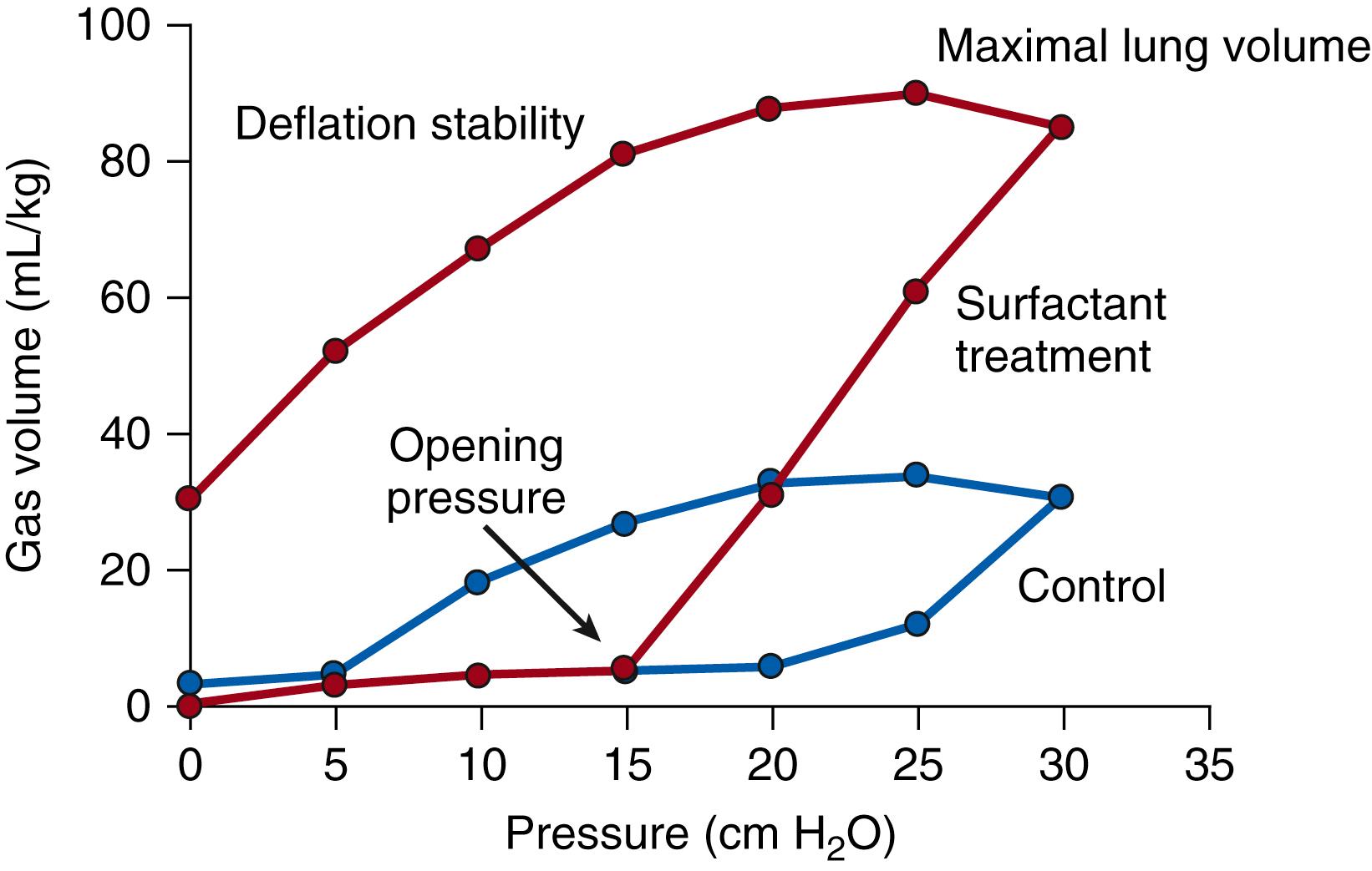
Evaluation of degree and uniformity of inflation is another measure of surfactant effects on the lung. Based on the simplest model of two alveoli as interconnecting spheres, surfactant deficiency will cause alveolar (or small airway) instability characterized by collapse of units with small radii and dilation of units with larger radii. This instability results from Laplace’s law: pressure at the surface of an alveolus = 2 × surface tension/radius. Because the alveolus is open to atmospheric pressure, the pressure outside must be balanced by the pressure on the inner surface or the alveolus will collapse. The forces acting on the alveolus are chest wall elasticity, lung tissue elasticity, and surface tensions at the alveolar surface and any continuous positive airway pressure (CPAP). All alveoli are not the same size. Therefore, Laplace’s law predicts that the retractive force of surface tension will be greater on the small alveoli than on the large alveoli, with the result being collapse of the small alveoli with further filling of the large alveoli. However, surfactant has the unique property of variable surface tension, depending on the rate and amount of surface area compression. As alveolar radius decreases, surface tension falls, limiting the collapse of the small alveolus. This stabilizing influence is lost in the absence of surfactant.
The concept of alveolar interdependence results from the scaling up of the alveolar model. Each alveolus depends on the position and elasticity of the neighboring alveolar walls to maintain normal shape and volume. If adjacent alveoli collapse, an alveolus either tends to overexpand and distort or collapse. In surfactant-deficient states, the more normal alveoli tend to overexpand as other regional alveoli collapse, generating a nonhomogeneously inflated lung. Surfactant treatment improves uniformity of inflation, minimizes small airway dilation, and promotes alveolar inflation. Surfactant treatment of 27-day preterm rabbits resulted in a distribution of alveolar sizes comparable to those of term rabbits ( Fig. 79.2 ). Surfactant treatment also resulted in more normal lung morphometry in preterm lambs receiving continuous mechanical ventilation 24 hours after delivery. The alveoli of the lambs not treated with surfactant were shallow, and alveolar ducts were dilated. Most of these abnormalities were prevented with surfactant treatment ( Fig. 79.3 ). This surfactant effect on uniformity of lung expansion may be the mechanism that decreases lung injury. There remains no sound consensus as to how to aerate the fluid-filled fetal lung to minimize injury. In new work by Tingay, the best approach may be a ramped increased in CPAP but not with a sigh.
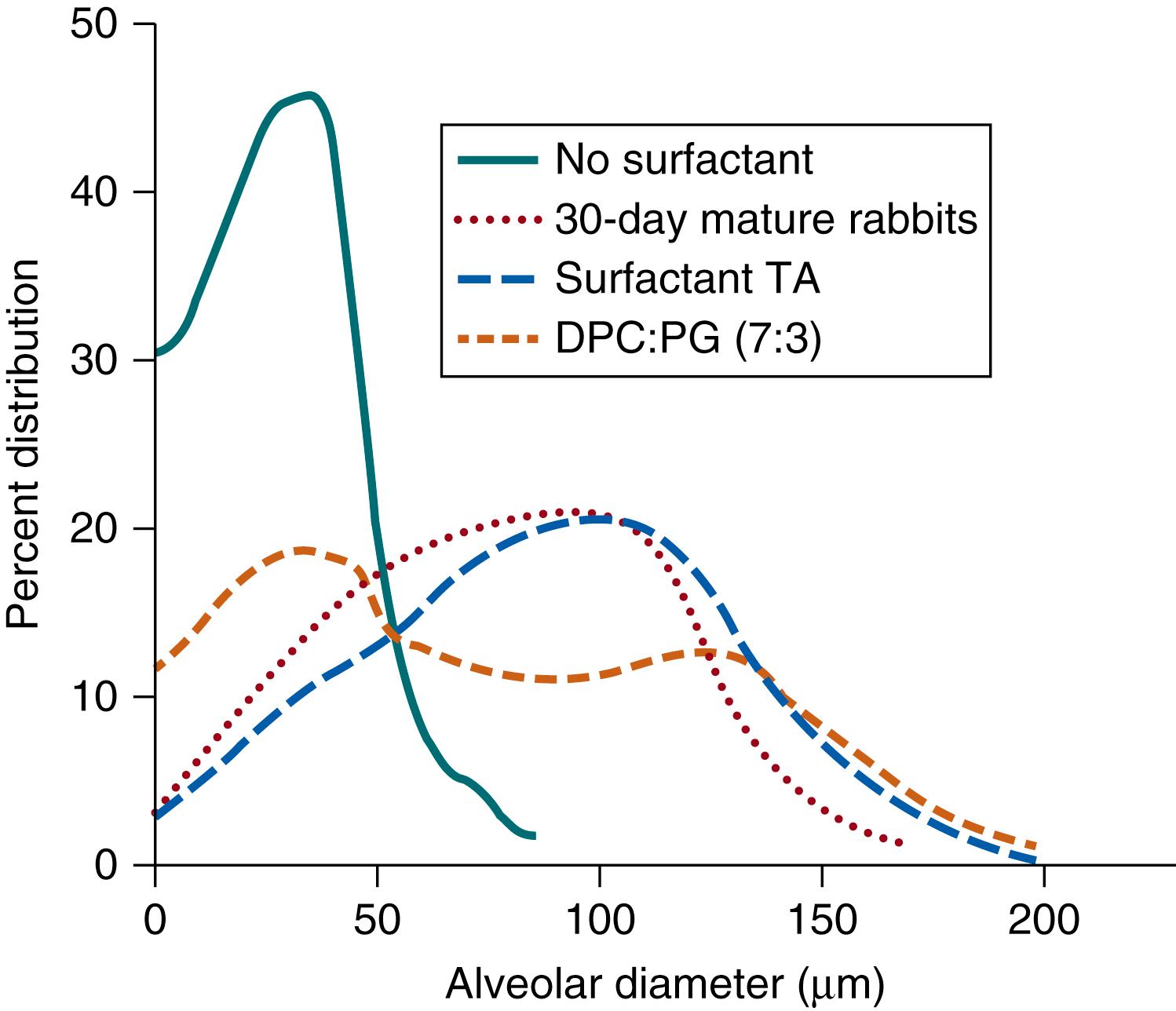
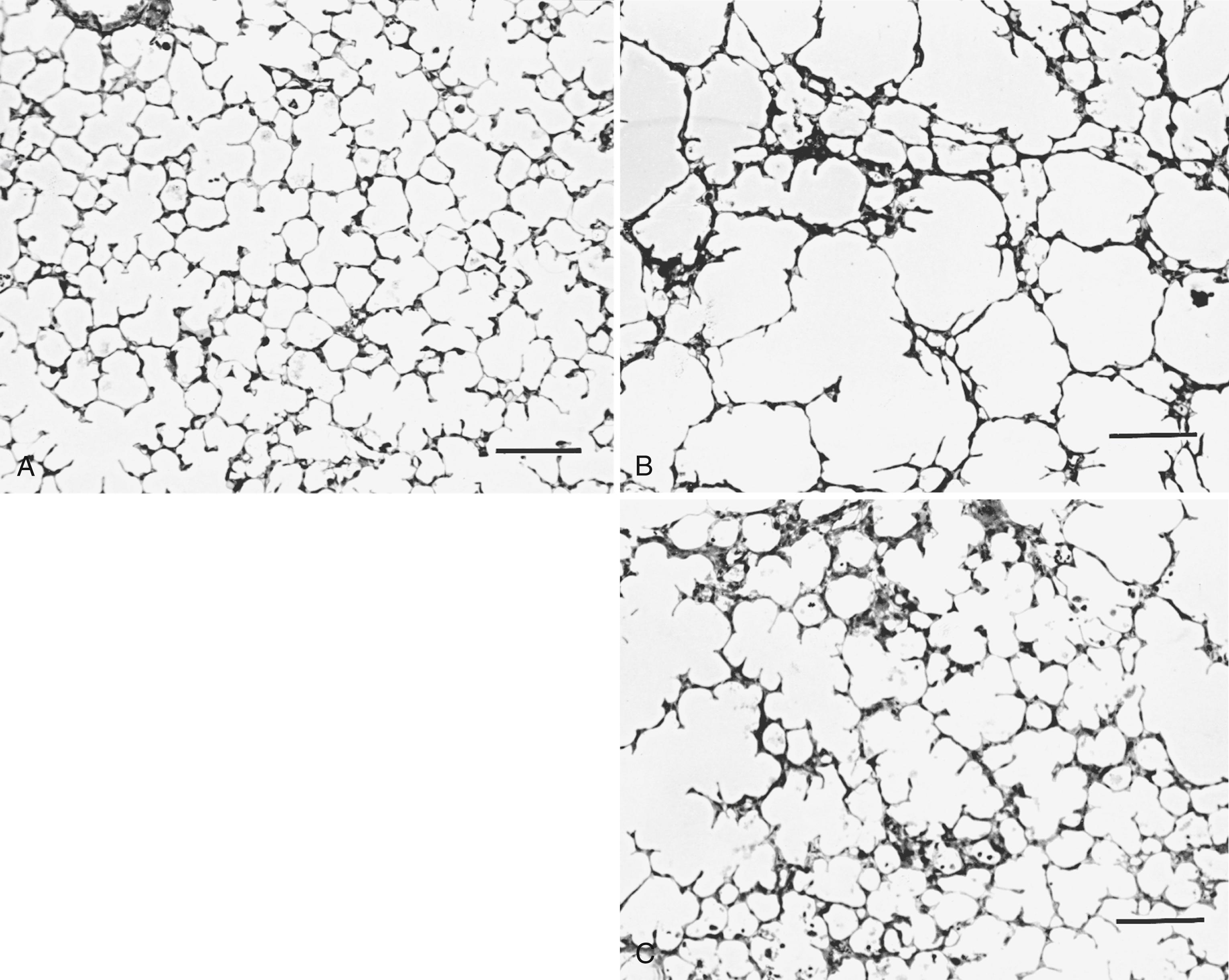
If surfactant treatment were to normalize lung function completely, functional residual capacity (FRC) will increase, the time constant for inflation will decrease, and the time constant for expiration will increase. These effects occur to variable degrees, probably depending on factors related to the disease progression in each infant, the style of ventilatory management, and the surfactant used to treat the infant. The example in Fig. 79.4 demonstrates that the combination of surfactant and positive end-expiratory pressure (PEEP) increases FRC in ventilated surfactant-deficient preterm rabbit lungs more than either intervention alone following the initial 4 to 6 breaths. The effect of surfactant predominates for breaths 39 to 41. FRC in infants with RDS increased by approximately 150% to approach a normal value after surfactant treatment in one report. In another report, FRC increased from 7.6 mL/kg to 15.4 mL/kg 1 hour after surfactant treatment. If PEEP is too high, FRC can be too high after surfactant treatment, resulting in CO 2 retention and a lower compliance.
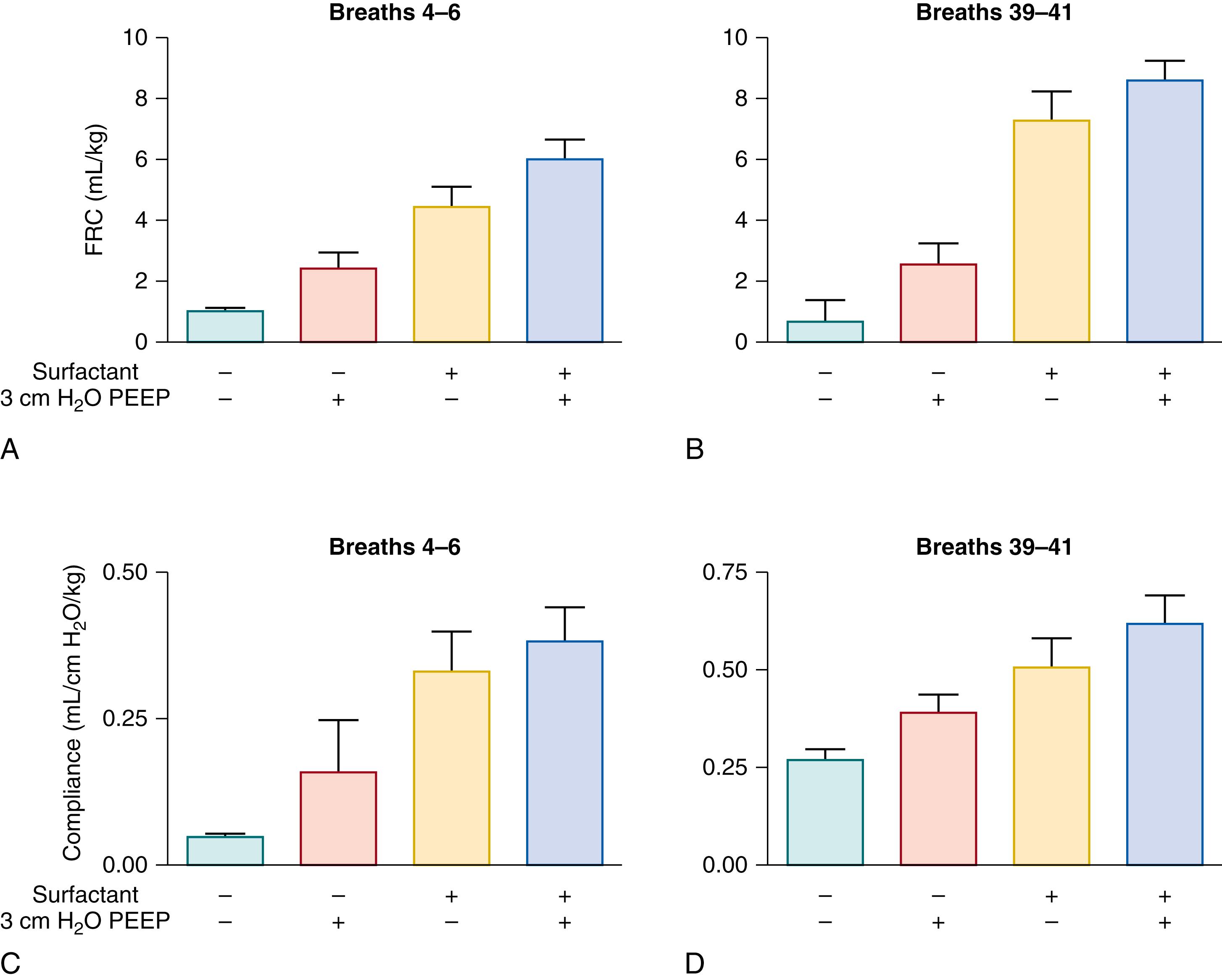
Compliance uniformly increases quickly in animal models of surfactant treatment. As with FRC, compliance increased by breaths 4 to 6 in mechanically ventilated preterm rabbits treated with surfactant, and further increases with breaths 39 to 41 were not large (see Fig. 79.4 ). Consistent with this rapid increase in lung compliance, Miedema and colleagues used electrical impedance tomography to measure 61% increases in lung gas volumes of infants treated with surfactant and high-frequency oscillation. However, compliance does not increase in infants soon after surfactant treatment in most clinical reports. For example, Davis and associates reported no change in compliance for mechanical breaths with surfactant treatments, although spontaneous breaths after surfactant treatment had improved compliance. There are several explanations for this inconsistency. The animal models of RDS are ventilated in a standard fashion often with control of tidal volume. In the clinical evaluations of surfactant, tidal volumes were seldom measured. Large tidal volumes or high FRC may mask a “compliance effect” of surfactant treatment. Kelly and associates found no improvement in dynamic compliance after treatment of infants with surfactant, whereas static compliance decreased as a result of lung volume recruitment. However, when the ventilator pressures were lowered, consistent improvements in both static and dynamic compliance occurred. The mix of PEEP, V T targets, rates, and other ventilator-driven variables can change the surfactant responses that are measured. If peak inspiratory pressures and/or PEEPs are too high, compliance will decrease after surfactant treatment because the lung is overinflated.
Another variable in the compliance response is the type of surfactant used for treatment. A synthetic surfactant without surfactant proteins may not improve compliance in the first few hours after treatment. In contrast, treatment with animal-source surfactants can result in rapid improvements in compliance. These different responses between synthetic surfactants and surfactant from animal lungs were noted in preterm animal models and in clinical practice. Differences in acute physiologic responses between the surfactants from animal lungs that are now used clinically are not large. New surfactants will need to be tested for effects on lung mechanics as they become available.
Surfactant treatments also will have effects on the time constants for lung inflation and deflation. The stiff, atelectatic lung of the infant with RDS does not inflate easily, and deflation to low lung volumes is rapid because the elastic recoil properties of the lungs are not counterbalanced by surfactant. With mechanical ventilation, inspiratory times and peak pressures are used empirically to adjust tidal volumes. The time constant for expiration (defined as the time required for the lung to empty two-thirds of its volume calculated from the peak tidal volume to FRC) is a passive property of the lung that is not controlled by the clinician. Although measurements of expiratory time constants have not been reported for surfactant-treated infants, the mean expiratory time constant increased from 25 ± 6 ms for controls to 50 ± 9 ms for surfactant-treated preterm rabbits. The expiratory time constant increased as the SP-B content of the surfactant increased in preterm rabbits. Increases in expiratory time constants in surfactant-treated infants ventilated at rapid rates could significantly increase expiratory lung volumes to the point of overdistention, resulting in decreased compliance and CO 2 retention. The combination of surfactant treatment and a ventilatory style that promotes air trapping may mask surfactant treatment effects. In contrast, lung that has not been “opened” may need long inspiratory times or higher pressure to recruit lung volume and avoid airway obstruction with surfactant treatment.
The most consistent response to surfactant treatment is an improvement in oxygenation, which occurs within seconds to minutes after surfactant treatment of preterm animals ( Fig. 79.5 ). The rapid improvement in oxygenation results from the acute increase in lung volume and increases in the surface area for gas exchange with surfactant instillation. Fig. 79.6 demonstrates the relationship between surfactant, ventilatory pressures, and oxygenation in infants with RDS who are ventilated with high-frequency oscillators. With initiation of ventilation, the mean airway pressures were increased until the oxygen need decreased to below 25%, and mean airway pressures of approximately 21 cm H 2 O were needed to open the lungs. The pressures were decreased until oxygenation decreased, and an optimal mean airway pressure was then determined. These pressures were lower with surfactant treatment. These results parallel the pressures needed to recruit lung volume in surfactant-deficient rabbit lungs (see Fig. 79.1 ). Surfactant treatments also decrease pulmonary vascular resistance in infants with RDS. Although the fall in pulmonary vascular resistance may reverse the ductal shunt (from right-to-left to left-to-right) and decrease hypoxic shunt, this effect is probably delayed in most clinical situations until after the initial oxygenation response has occurred. Surfactant treatments also can improve overall hemodynamics with an increase in systemic blood flow. These changes in hemodynamics may acutely alter cerebral perfusion and the electroencephalogram.
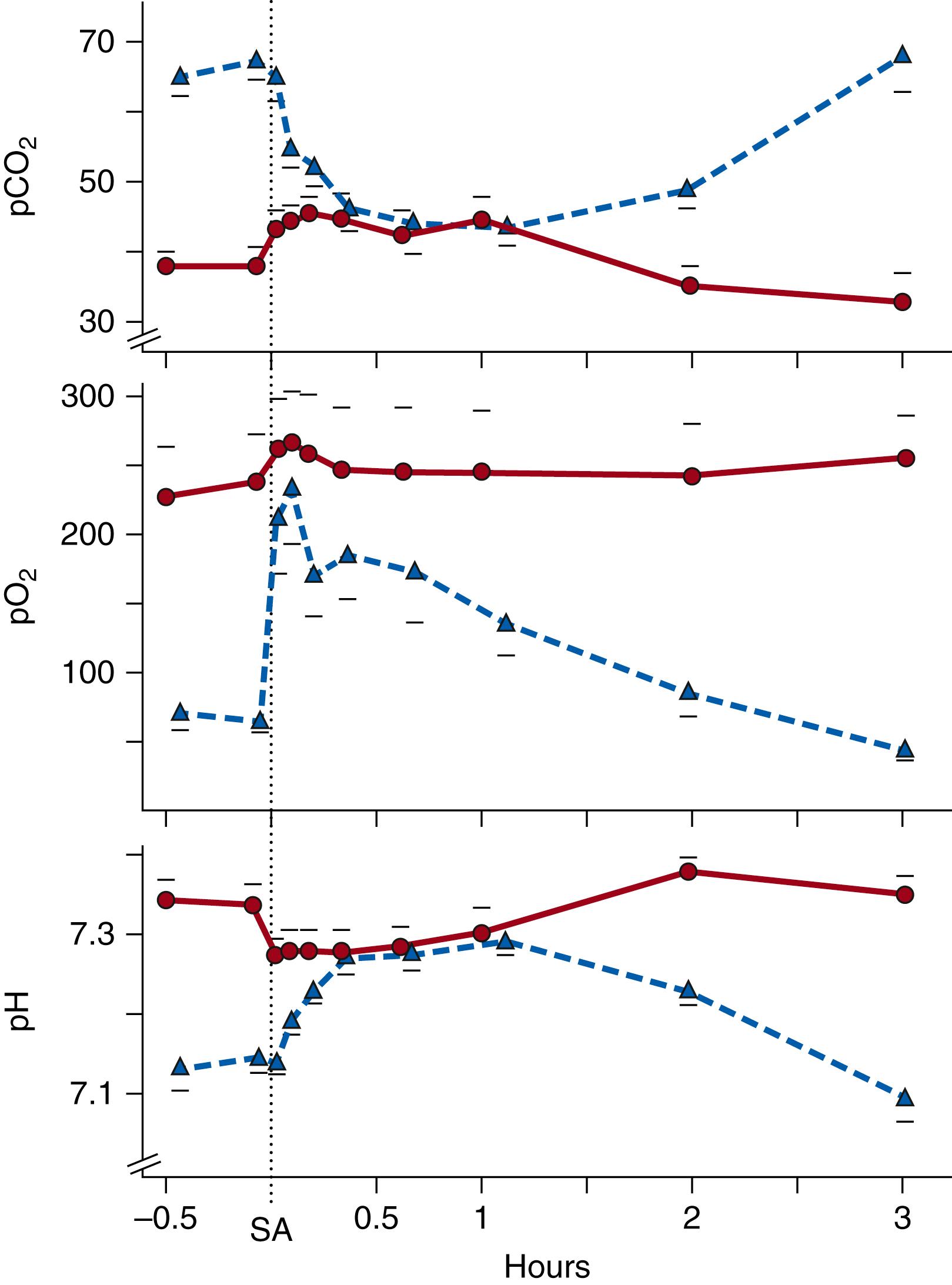
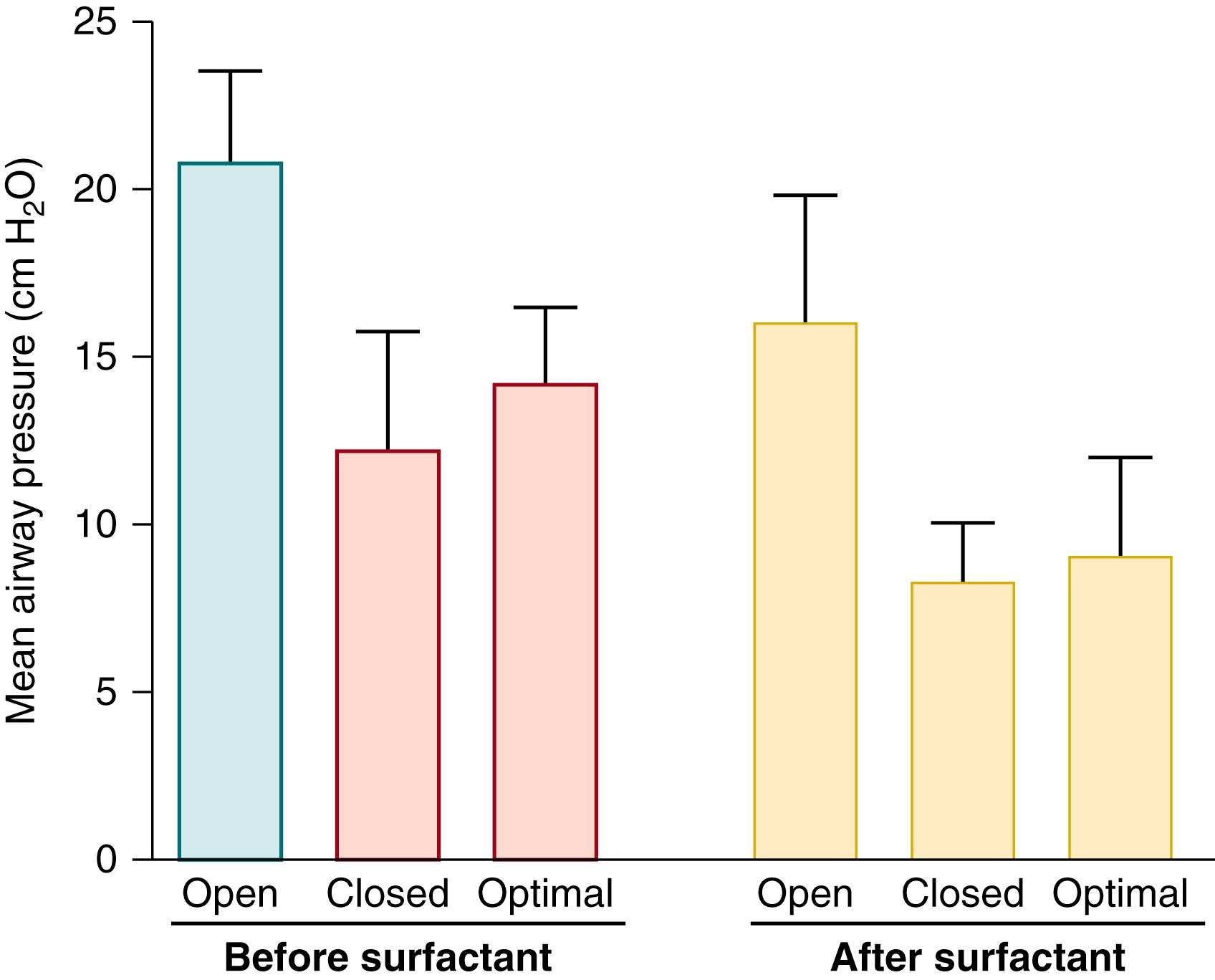
Become a Clinical Tree membership for Full access and enjoy Unlimited articles
If you are a member. Log in here